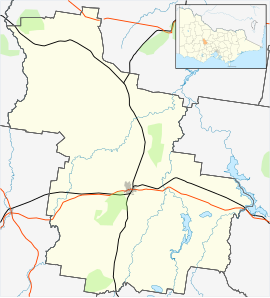Talbot, Victoria
|
Talbot Victoria |
|
|---|---|

Scandinavian Crescent in Talbot
|
|
| Coordinates | 37°10′0″S 143°42′0″E / 37.16667°S 143.70000°ECoordinates: 37°10′0″S 143°42′0″E / 37.16667°S 143.70000°E |
| Population | 258 (2011 census) |
| Postcode(s) | 3371 |
| Location |
|
| LGA(s) | Shire of Central Goldfields |
| State electorate(s) | Ripon |
| Federal Division(s) | Wannon |
Talbot is a town in Victoria, Australia. At the 2011 census, Talbot had a population of 258.
In September 1836, Major Thomas Livingstone Mitchell and his party reached the Talbot district and passed in the vicinity of Mount Greenock. Upon his return to Sydney he gave impressive reports as to the suitability of the land for sheep grazing. The settlement commenced when Alexander McCallum arrived in the area in June 1841. A grazing lease for Dunach Forest, an area of 63,640 acres (257.5 km²) was granted to him on April 1, 1848. Donald Cameron had already established himself at Clunes in 1839. For the next decade the area was not greatly changed by the efforts of the settlers who lived and raised their flocks in the solitude of the bush. This peaceful scene was soon to change as the news of gold find spread throughout the colonies and to Europe and America.
With the discovery of gold, the pleasant pastoral scene changed as the gold seekers from various parts of the world invaded the country-side looking for the precious metal. The first unofficial record of a discovery of gold in the area was at Daisy Hill on Hall and McNeill’s ‘Glen Mona Run’. The discovery was made by a shepherd, Thomas Chapman. This discovery was not reported for fear of prosecution for gold digging. Official gold finds in Victoria date from 1851, but there is evidence of many unofficial finds like the one at Glen Mona. The first official discovery in the area around Talbot was made by two South Australians and their families at Daisy Hill Creek (later Amherst) in 1852. One of the men was Cowley, the other was John Potter. Potter claimed they unearthed a nugget while trying to free a bogged wagon. The rush to Daisy Hill followed his discovery. Amherst was first called by that name in official letters in May 1853. The population in those early years drifted up and down according to the reports from other areas. The miners started to test the ground around Back Creek and soon discoveries were made. During 1854 the only mining at Back Creek was on the creek about 2 and half miles from Amherst. Later in 1854 there was a big rush to Amherst and Back Creek. The rich ground of Ballarat Hill, Nuggetty Gully and Kangaroo Flat (Carallulup) were opened up. At the beginning of 1855 there were about 2500 diggers and store owners at Back Creek as well as 300 women and children. There was a certain amount of crime on the gold fields. Horse stealing, burglaries and violence were common.
...
Wikipedia

